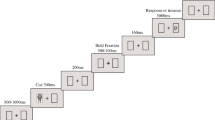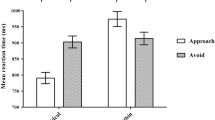Abstract
The present study examined the associations among biased attentional responding to thin-ideal bodies, appearance comparisons, eating disorder-specific rumination, and body dissatisfaction. Sixty-seven females completed an attentional task capable of independently assessing biased attentional engagement with, and biased attentional disengagement from, images of thin-ideal bodies relative to images of non-thin bodies. Self-report measures of the other relevant constructs were also taken. Results revealed that a heightened tendency to engage in appearance comparisons was predicted by increased attentional engagement with thin-ideal bodies but not by impaired attentional disengagement from thin-ideal bodies. Moreover, a serial mediation analysis revealed that increased attentional engagement with thin-ideal bodies was associated with greater appearance comparison, which in turn was associated with greater eating disorder-specific rumination and consequently greater body dissatisfaction. The current findings suggest that increased attentional engagement with thin-ideal bodies might represent a pathway to body dissatisfaction, mediated by greater appearance comparison and eating-disorder specific rumination.



Similar content being viewed by others
Data Availability
The original dataset associated with this work can be found in the following Open Science Framework data deposit: https://osf.io/k6qzx/.
Notes
In the context of the current study, the term “non-thin” describes bodies estimated to be in the overweight/mildly obese weight range.
Overall level of accuracy for each of these three participants fell below 55%.
A post-hoc Monte Carlo power simulation (Schoemann, Boulton, & Short, 2017) revealed that the current study had 80% power [CI .79–.82] to detect the observed serial mediation effect.
A variation of the proposed serial mediation pathway, in which the order of the mediators was reversed, did not yield a serial mediation effect (β = .05, SE = .05, 95% CI = −.04, .18).
References
Cafri, G., Yamamiya, Y., Brannick, M., & Thompson, J. K. (2006). The influence of sociocultural factors on body image: A meta-analysis. Clinical Psychology: Science and Practice, 12(4), 421–433. https://doi.org/10.1093/clipsy.bpi053.
Cho, A., & Lee, J. H. (2013). Body dissatisfaction levels and gender differences in attentional biases toward idealized bodies. Body Image, 10(1), 95–102. https://doi.org/10.1016/j.bodyim.2012.09.005.
Clarke, P. J. F., MacLeod, C., & Guastella, A. J. (2013). Assessing the role of spatial engagement and disengagement of attention in anxiety-linked attentional bias: A critique of current paradigms and suggestions for future research directions. Anxiety, Stress and Coping, 26(1), 1–19. https://doi.org/10.1080/10615806.2011.638054.
Cooper, P. J., Taylor, M. J., Cooper, Z., & Fairbum, C. G. (1987). The development and validation of the body shape questionnaire. International Journal of Eating Disorders, 6(4), 485–494. https://doi.org/10.1002/1098-108X(198707)6:4<485::AID-EAT2260060405>3.0.CO;2-O.
Cowdrey, F. A., & Park, R. J. (2011). Assessing rumination in eating disorders: Principal component analysis of a minimally modified ruminative response scale. Eating Behaviors, 12(4), 321–324. https://doi.org/10.1016/j.eatbeh.2011.08.001.
Cowdrey, F. A., & Park, R. J. (2012). The role of experiential avoidance, rumination and mindfulness in eating disorders. Eating Behaviors, 13(2), 100–105. https://doi.org/10.1016/j.eatbeh.2012.01.001.
Dondzilo, L., Rieger, E., Palermo, R., Byrne, S., & Bell, J. (2016). Association between rumination factors and eating disorder behaviours in young women. Advances in Eating Disorders, 4(1), 84–98. https://doi.org/10.1080/21662630.2015.1118642.
Dondzilo, L., Rieger, E., Palermo, R., Byrne, S., & Bell, J. (2017). The mediating role of rumination in the relation between attentional bias towards thin female bodies and eating disorder symptomatology. PLoS One, 12(5), e0177870. https://doi.org/10.1371/journal.pone.0177870.
Etu, S. F., & Gray, J. J. (2010). A preliminary investigation of the relationship between induced rumination and state body image dissatisfaction and anxiety. Body Image, 7(1), 82–85. https://doi.org/10.1016/j.bodyim.2009.09.004.
Feinstein, B. A., Hershenberg, R., Bhatia, V., Latack, J. A., Meuwly, N., & Davila, J. (2013). Negative social comparison on Facebook and depressive symptoms: Rumination as a mechanism. Psychology of Popular Media Culture, 2(3), 161–170. https://doi.org/10.1037/a0033111.
Grafton, B., & MacLeod, C. (2014). Enhanced probing of attentional bias: The independence of anxiety-linked selectivity in attentional engagement with and disengagement from negative information. Cognition and Emotion, 28(7), 1287–1302. https://doi.org/10.1080/02699931.2014.881326.
Grafton, B., Watkins, E., & MacLeod, C. (2012). The ups and downs of cognitive bias: Dissociating the attentional characteristics of positive and negative affectivity. Journal of Cognitive Psychology, 24(1), 33–53. https://doi.org/10.1080/20445911.2011.578066.
Grafton, B., Southworth, F., Watkins, E., & MacLeod, C. (2016). Stuck in a sad place: Biased attentional disengagement in rumination. Emotion, 16(1), 63–72. https://doi.org/10.1037/emo0000103.
Hayes, A. F. (2009). Beyond baron and Kenny: Statistical mediation analysis in the new millennium. Communication Monographs, 76(4), 408–420. https://doi.org/10.1080/03637750903310360.
Holender, D. (1986). Semantic activation without conscious identification in dichotic listening, parafoveal vision, and visual masking: A survey and appraisal. Behavioral and Brain Sciences, 9(1), 1–23. https://doi.org/10.1017/S0140525X00021269.
Jiang, M. Y. W., & Vartanian, L. R. (2016). The role of memory in the relationship between attention toward thin-ideal media and body dissatisfaction. Eating and Weight Disorders – Studies on Anorexia, Bulimia and Obesity, 21(1), 57–64. https://doi.org/10.1007/s40519-015-0196-x.
Jonker, N. C., Glashouwer, K. A., Hoekzema, A., Ostafin, B. D., & de Jong, P. J. (2019). Attentional engagement with and disengagement from food cues in anorexia nervosa. Behaviour Research and Therapy, 114(December 2018), 15–24. https://doi.org/10.1016/j.brat.2019.01.003.
Joseph, C., LoBue, V., Rivera, L. M., Irving, J., Savoy, S., & Shiffrar, M. (2016). An attentional bias for thin bodies and its relation to body dissatisfaction. Body Image, 19, 216–223. https://doi.org/10.1016/j.bodyim.2016.10.006.
Lyu, Z., Zheng, P., & Wang, Z. (2018). Time course of Attentional biases toward body shapes in women who are overweight or obese. Cognitive Therapy and Research., 43, 594–602. https://doi.org/10.1007/s10608-018-9978-6.
MacLeod, C., Mathews, A., & Tata, P. (1986). Attentional bias in emotional disorders. Journal of Abnormal Psychology, 95(1), 15–20. https://doi.org/10.1037/0021-843X.95.1.15.
Mogg, K., Bradley, B. P., & Williams, R. (1995). Attentional bias in anxiety and depression: The role of awareness. British Journal of Clinical Psychology, 34(1), 17–36. https://doi.org/10.1111/j.2044-8260.1995.tb01434.x.
Mond, J., Mitchison, D., Latner, J., Hay, P., Owen, C., & Rodgers, B. (2013). Quality of life impairment associated with body dissatisfaction in a general population sample of women. BMC Public Health, 13(1). https://doi.org/10.1186/1471-2458-13-920.
Moussally, J. M., Brosch, T., & Van der Linden, M. (2016). Time course of attentional biases toward body shapes: The impact of body dissatisfaction. Body Image, 19, 159–168. https://doi.org/10.1016/j.bodyim.2016.09.006.
Myers, T. A., & Crowther, J. H. (2009). Social comparison as a predictor of body dissatisfaction: A meta-analytic review. Journal of Abnormal Psychology, 118(4), 683–698. https://doi.org/10.1037/a0016763.
Rivière, J., Rousseau, A., & Douilliez, C. (2018). Effects of induced rumination on body dissatisfaction: Is there any difference between men and women? Journal of Behavior Therapy and Experimental Psychiatry, 61(September 2017), 1–6. https://doi.org/10.1016/j.jbtep.2018.05.005.
Rodgers, R. F., & DuBois, R. H. (2016). Cognitive biases to appearance-related stimuli in body dissatisfaction: A systematic review. Clinical Psychology Review, 46, 1–11. https://doi.org/10.1016/j.cpr.2016.04.006.
Rosen, J. C., Jones, A., Ramirez, E., & Waxman, S. (1996). Body shape questionnaire: Studies of validity and reliability. International Journal of Eating Disorders, 20(3), 315–319. https://doi.org/10.1002/(SICI)1098-108X(199611)20:3<315::AID-EAT11>3.0.CO;2-Z.
Rudaizky, D., Basanovic, J., & MacLeod, C. (2014). Biased attentional engagement with, and disengagement from, negative information: Independent cognitive pathways to anxiety vulnerability? Cognition and Emotion, 28(2), 245–259. https://doi.org/10.1080/02699931.2013.815154.
Schaefer, L. M., & Thompson, J. K. (2014). The development and validation of the physical appearance comparison scale-revised (PACS-R). Eating Behaviors, 15(2), 209–217. https://doi.org/10.1016/j.eatbeh.2014.01.001.
Schoemann, A. M., Boulton, A. J., & Short, S. D. (2017). Determining power and sample size for simple and complex mediation models. Social Psychological and Personality Science, 8(4), 379–386. https://doi.org/10.1177/1948550617715068.
Stice, E., & Shaw, H. E. (2002). Role of body dissatisfaction in the onset and maintenance of eating pathology. Journal of Psychosomatic Research, 53(5), 985–993. https://doi.org/10.1016/S0022-3999(02)00488-9.
Stice, E., Marti, C. N., & Durant, S. (2011). Risk factors for onset of eating disorders: Evidence of multiple risk pathways from an 8-year prospective study. Behaviour Research and Therapy, 49(10), 622–627. https://doi.org/10.1016/j.brat.2011.06.009.
Stice, E., Gau, J. M., Rohde, P., & Shaw, H. (2017). Risk factors that predict future onset of each DSM–5 eating disorder: Predictive specificity in high-risk adolescent females. Journal of Abnormal Psychology, 126(1), 38–51. https://doi.org/10.1037/abn0000219.
Thompson, J. K., & Stice, E. (2001). Thin-ideal internalization: Mounting evidence for a new risk factor for body-image disturbance and eating pathology. Current Directions in Psychological Science, 10(5), 181–183. https://doi.org/10.1111/1467-8721.00144.
Thompson, J. K., Heinberg, L. J., Altabe, M., & Tantleff-Dunn, S. (1999). Exacting beauty: Theory, assessment, and treatment of body image disturbance. American Psychological Association. Washington, DC: American Psychological Association. https://doi.org/10.1037/10312-000.
Warschburger, P., Calvano, C., Richter, E. M., & Engbert, R. (2015). Analysis of attentional bias towards attractive and unattractive body regions among overweight males and females: An eye-movement study. PLoS One, 10(10), e0140813. https://doi.org/10.1371/journal.pone.0140813.
Watkins, E., Scott, J., Wingrove, J., Rimes, K., Bathurst, N., Steiner, H., Kennell–Webb, S., Moulds, M., & Malliaris, Y. (2007). Rumination-focused cognitive behaviour therapy for residual depression: A case series. Behaviour Research and Therapy, 45(9), 2144–2154. https://doi.org/10.1016/j.brat.2006.09.018.
Authorship
Laura Dondzilo: Conceptualization, Methodology, Formal analysis, Writing - original draft & editing. Julian Basanovic: Methodology, Writing - review & editing. Ben Grafton: Methodology, Writing - review & Editing. Jason Bell: Methodology & Resources. Georgia Turnbull: Data collection. Colin MacLeod: Conceptualization, Methodology, Writing - review & editing. All authors approved the final version of the paper for submission.
Funding
This research was partly supported by Australian Research Council grants DP170104533 and FL170100167.
Author information
Authors and Affiliations
Corresponding author
Ethics declarations
Ethics Approval
Ethical approval for this study was given by the University of Western Australia’s Human Research Ethics Committee.
Conflict of Interest
The authors declare no conflict of interest.
Additional information
Publisher’s Note
Springer Nature remains neutral with regard to jurisdictional claims in published maps and institutional affiliations.
Rights and permissions
About this article
Cite this article
Dondzilo, L., Basanovic, J., Grafton, B. et al. A serial mediation model of attentional engagement with thin bodies on body dissatisfaction: The role of appearance comparisons and rumination. Curr Psychol 42, 1896–1904 (2023). https://doi.org/10.1007/s12144-021-01574-1
Accepted:
Published:
Issue Date:
DOI: https://doi.org/10.1007/s12144-021-01574-1




